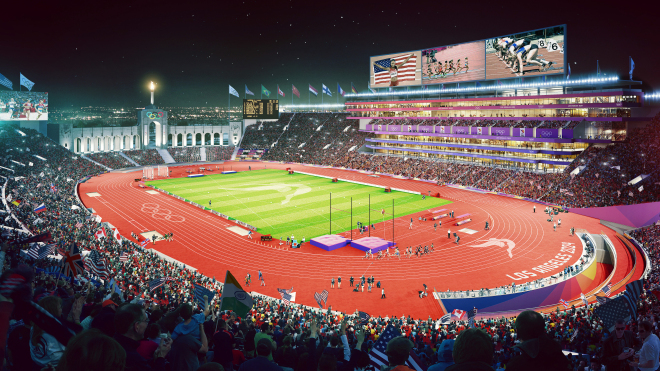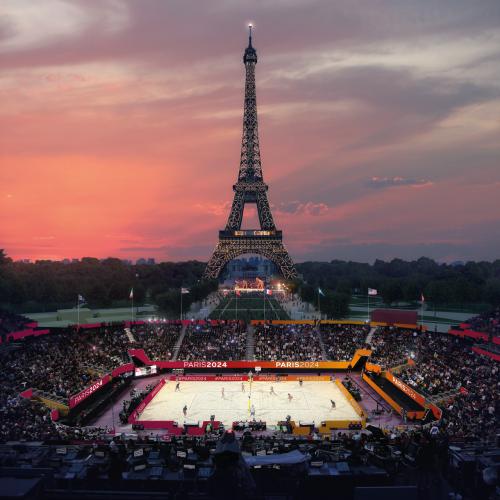Paris and Los Angeles are set to host the 2024 and 2028 Olympic Games, respectively. Hosting the games will offer these cities the chance to showcase not only their countries’ finest athletes, but also their technological innovation and cultural vibrancy. However, preparing for the Olympics also presents massive infrastructural, economic, and environmental challenges.
With the world watching, these challenges are especially visible leading up to the games. But they also reflect a broader sustainable development challenge faced by policymakers in an urbanizing world: how to make massive infrastructure investments to accommodate large flows of people while limiting both costs and environmental impact?
As international environmental leaders, Paris and L.A. are well-positioned to clear these hurdles. Since facilitating the 2015 Paris Climate Agreement, France has emerged as one of Europe’s climate leaders, setting an ambitious goal of reducing its carbon emissions 37% by 2030. Likewise, the state of California has become a global advocate for climate change mitigation, even as President Trump seeks to withdraw the United States from the Paris Agreement.
 |
Winning the nod from the International Olympic Committee generates fierce competition among cities. And while victory in the bid process is sweet, actually hosting the world’s largest sporting event often leaves a sour taste in the mouth of host countries. The most visible impact is the sheer cost of building the necessary sports venues, transportation infrastructure, and housing supply—not to mention the costs of providing food, entertainment, security, and medical services during the games.
Almost always, the final price tag exceeds the initial budget projection. Worse, the resulting stadiums and apartment buildings built for the Games soon become stranded assets. Stadiums from the Rio and Athens games have quickly fallen into disrepair, while Beijing has struggled to make consistent use of its famed Bird’s Nest.
The sports venues can likewise be damaging to important ecological areas. The Olympic golf course from the Rio games, for example, drew criticism for its controversial placement next to (and on top of) the Marapendi lagoon, a protected wilderness area that is part of the Mata Atlântica biome, which contains the highest biodiversity on earth.
The Olympic Games also exact immense tolls on energy and water use. The estimated resource impacts from the Rio Games were that 17,000 tons of solid waste would be produced, 6,000 tons of food would be consumed, and 29,500 gigawatts of electricity would be used over the course of the games. Similarly, the Rio Games produced an estimated 3.6 million tons of greenhouse gas emissions (though the government pledged to offset through reforestation and renewable energy initiatives).
As London displayed in 2012, focusing on sustainability can limit both the environmental impacts of the games and help the host city stay within its budget. Indeed, Paris and L.A. have the experience to overcome these dual challenges. Each city will host the games for a third time, meaning they can build on past innovations. In 1984, L.A. became the first city to turn a profit on the games by making extensive use of existing infrastructure and leveraging private-sector partnerships to defray costs. Likewise, in March 2017, Paris took an early lead by becoming the first Olympic candidate city to receive the ISO 20121 certification, an international best practices award for sustainable management of global events.
 |
Taking a page from the 1984 playbook, L.A.’s sustainability vision for the games outlines the city’s plan to once again “work with what L.A. already has.” Taking a “radical re-use” approach, the city has said that 100% of the venues of the games will be either temporary or developed from existing structures. Likewise, Paris has pledged that 95% of its venues will be either existing or temporary structures. In addition to lowering construction costs, this approach helps limit urban sprawl.
Transportation poses another major challenge—and opportunity—for innovation. An estimated 2 million people traveled to London for the 2012 Olympiad.
Preparing for this massive influx motivated London, which has struggled with air pollution in the past, to invest heavily in its public transportation as well as its bicycle and pedestrian infrastructure. These investments paid off: 86% of spectators in London travelled to events by train, and following the games, the city reported a 29% increase in cyclists within central London over the previous year.
Similarly, L.A. and Paris have set a goal that 100% of trips made to stadiums will be made via public transit or through ride-sharing platforms. In fact, L.A. has already made plans to invest $88 billion in a public transit system that is set to be one of the world’s largest by the time the games open.
Lastly, both Paris and L.A. have worked to tackle the resource use challenges of the games through private-sector partnerships. In its sustainability vision, L.A. highlights its existing commitment to produce at least 40% of its energy from renewable sources by 2024. The city will also work with private venues such as the Staples Center and regional energy utilities to produce the other 60% of its energy needs through renewables by 2028—which would make L.A. the first “energy-positive” games.
Paris has taken a similar approach with regard to solid waste management, partnering with the international environmental management firm Suez to recycle or re-use 95% of the waste produced during the games. Other corporate partners such as AirFrance, BNP Paribas, and LaCoste have all signed on to support Paris’ sustainability vision.
Perhaps most importantly, both cities have highlighted sustainability not as one feature of their plans, but instead as a guiding ethic. L.A. will feature an entire Green Sports Park, to highlight an array of sustainable technologies including urban farming, rooftop rainwater capture, and living green walls. Paris has also focused on eco-friendly practices throughout the supply chain, by promoting environmentally conscious hotels and contracting Fair Trade Certified food vendors. Likewise, this integration of sustainability into all public infrastructure and development plans is critical for addressing global challenges like climate change, which span industries, sectors, and international boundaries.
With 7 and 11 years left to go before the 2024 and 2028 games, achieving a green Olympics will be more of a marathon than sprint, but if Paris and L.A. are able to light a torch of sustainability, the light will shine for decades to come.
